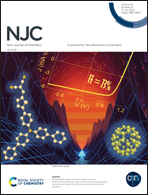Optimal strategy based on radiation chemistry for facile and direct synthesis of poly(3-thiophene acetic acid) polymers in water and dichloromethane
Abstract
In this work, synthesis of nanostructured conducting poly(3-thiophene acetic acid) (PTAA) polymers was developed by means of γ-induced oxidative polymerization of TAA monomers dissolved either in water or in dichloromethane. This synthesis was shown to be facile and directly feasible without any prior esterification of TAA and in the absence of oxidizing agents. Radiolytic yields of TAA oxidation as well as irradiation doses required for quantitative PTAA preparation were determined for each solvent. UV-Vis and ATR-FTIR spectroscopies demonstrated the successful formation of two PTAA polymers, so-called “PTAAH2O” and “PTAACH2Cl2”. Size exclusion chromatography (SEC) highlighted convergent molecular weight values corresponding to approximately 13 monomer units. A similar behavior for both radio-synthesized PTAAs was monitored by thermogravimetric analysis (TGA). The morphological structures of PTAAH2O and PTAACH2Cl2 were analyzed in solution by Cryo-TEM and after deposition by SEM and AFM. Microscopic observations revealed the presence of two distinguishable nanostructures: nano-spherules of several hundreds of nanometers made of PTAAH2O and nano-granules of several tens of nanometers made of PTAACH2Cl2. Cyclic voltammetry analysis and the Tauc plot method were employed to calculate the electrical and optical band gaps. Both polymers possess similar electrical band gaps. However, PTAACH2Cl2 affords a lower optical band gap than PTAAH2O. Four-point probe measurements showed that the radio-synthesized PTAA polymers are characterized by interesting electrical properties: a higher electrical conductivity was nevertheless recorded for PTAACH2Cl2. This study highlights the powerful ability of the radiation chemistry-based methodology to lead, as a simple, versatile and reliable method, to nanostructured PTAA conducting polymers either in aqueous or organic solutions.



 Please wait while we load your content...
Please wait while we load your content...